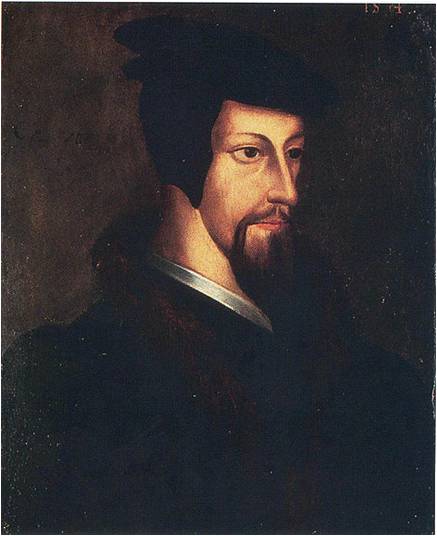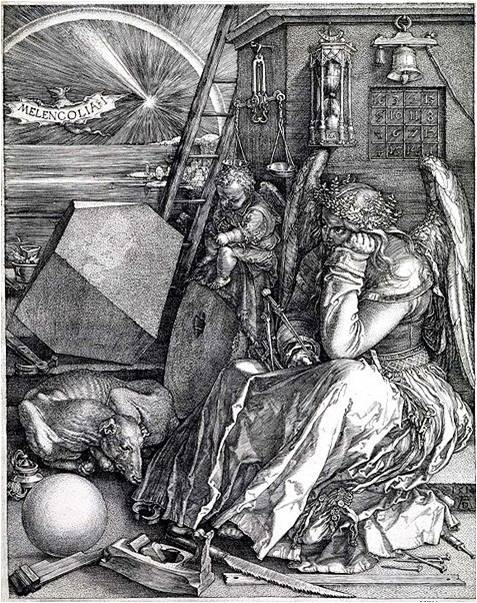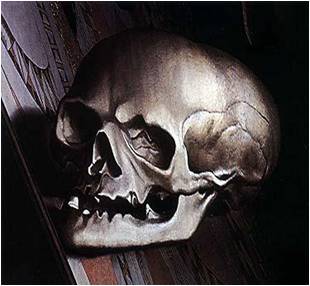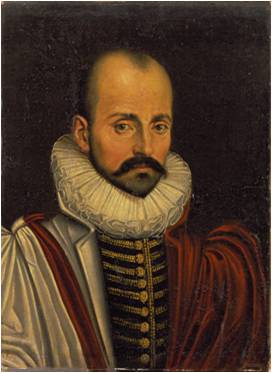| Northern Renaissance |
| I. Christian Humanism
A. Spread of the Renaissance
B. Protestant Reformation:
II. Northern Renaissance Art
A. Jan van Eyck
B. Bosch
C. Dürer
D. Grünewald
E. Holbein
F. Brueghel
A. Erasmus
B. More
C. Cervantes
D. Rabelais
E. Montaigne
|
| I. Christian Humanism |
|
Definition: Christian humanists’ critical reappraisal of religious texts.
Causes:
A. Acquisition of Greek made it possible to have a much more accurate knowledge of the Gospels.
B. Advances in print technology: Johann Gutenberg’s movable metal type.
C. Rediscovery of the historical core of Christianity: direct relationship between God and the individual. (Fiero 474; Lucie-Smith 208)
|
| Desiderius Erasmus (1466-1536) |
|
-The Prince of Christian Humanism
-Corrected St. Jerome’s mistranslations of the New Testament
Albrecht Dürer, Desiderius Erasmus of Rotterdam, 1526

Wikipaintings—Encyclopedia of Painting. Web. 8 Dec 2011.
http://www.wikipaintings.org/en/albrecht-durer/desiderius-erasmus-of-rotterdam-1526
|
| A. The Spread of the Renaissance |
| 1. "Europe north of the Alps was dominated by powerful territorial rulers and a rural nobility. Its ethos
of ‘hunting, women and banquets’ was completely different from the civic values of Italy” (Black et
al. 24).
2. “In Germany and the Low Countries the art and humanism of the Renaissance were affected by a
deeper, northern spirituality that was entirely alien to Italy.”
3. “Concern for man’s spiritual welfare led to an increased dissatisfaction with the dogma, luxury and
corruption of the Church” (Black et al. 24).
4. “The diffusion of the Renaissance resulted not in cultural uniformity, but in a diversity of separate
national movement. Its passage north of the Alps thus reinforced Europe’s division into independent
and competing national states . . .” (Black et al. 24).
|
| devotio moderna |
|
“modern devotion”: a movement of lay piety and anticlericalism in the Netherlands

Tower Books. Web. 26 Dec 2011.
http://www.tower.com/imitation-christ-thomas-a-kempis-hardcover/wapi/111477637
|
| Thomas a Kempis (1380-1471) |
|
Wrote Imitatio Christi (Imitation of Christ)
Leader of the Devotio moderna (modern devotion) movement
Lay Brothers and Sisters of the Common Life
(Fiero 474)
|
| Christian Humanism |
| B. The Protestant Reformation |
|
A. The Protestant Reformation:
1. Martin Luther
2. John Calvin
B. Spread of Protestantism
C. Henry VIII and the English Reformation:
|
| Martin Luther (1483-1546) |
|
An Augustinian monk
1517: posted his Ninety-Five Theses on the door of the collegiate church at Wittenberg

Home Page of the Reformed Presbyterian Church (Convenated). Web. 9 Dec 2011.
http://www.covenanter.org/Luther/luther.jpg
|
| Luther''s Theological Premises |
|
(1) justification by faith
(2) the primacy of Scripture
(3) the priesthood of all believers
(Coffin et al. 491)
Influences:
(1) Excommunicated by Pope X in 1520 and charged with heresy by the Diet of Worms in 1521.
(2) Yet backed up by Frederick the Wise and other German princes who were in search of state sovereignty
(3) Also gained the support of the German populace because of their fervent nationalism (Fiero 477).
|
| John Calvin (1509-1564) |
|
A French theologian who later settled in Geneva, Switzerland and became its spiritual leader.
His ideas gave rise to the Puritan movement in 17th century England and the Presbyterian churches in
Scotland and Ireland. Both traditions had great influence on the English colonies in North America.
(Perry, Peden, and Von Laue 319-20).

Wikipedia. Web. 9 Dec 2011.
http://en.wikipedia.org/wiki/File:John_Calvin_-_Young.jpg
Differences from Luther:
1. advocated aggressive Christian conduct
2. more legalistic; closer to an Old Testament faith
3. insisted on eliminating all traces of church hierarchy and keeping the barest simplicity in church services.
|
| Spread of Protestantism |
|
1520s: Lutheranism became state religion in Denmark, Norway, and Sweden
1534: England broke with Rome
1541: Geneva adopted theocratic government based on Calvinism.
1540-1560s: Calvinism spread to Scotland, England, Netherlands, and France
|
| The English Reformation |
| Henry VIII (1509-1547) |
|
Political considerations, not theological differences: Broke with Rome because the pope refused to annul
his first marriage.
1534: In the Act of Supremacy, the parliament declared him supreme head of the Church of England.

Wikipedia. Web. 9 Dec 2011.
http://en.wikipedia.org/wiki/File:Hans_Holbein_d._J._074.jpg
|
| Elizabeth I (1558-1603) |
|
1559: the Elizabethan compromise
1) In favor of Protestantism
2) Retained church government by bishops

Wikipedia. Web. 9 Dec 2011.
http://zh.wikipedia.org/wiki/File:Elizabeth1England.jpg

|
| II. Northern Renaissance Art |
- Style: Detailed realism
- Subject matters: devotional works, biblical themes such as death and human folly, everyday life of ordinary folk
- New genres: printworks (engraving), genre painting
|
| Artists |
|
Jan van Eyck (1380-1441)
Hieronymus Bosch (1460-1516)
Albrecht Dürer (1471-1528)
Grünewald (1460-1528)
Hans Holbein (1497-1543)
Pieter Brueghel (1529-69)
|
| Jan van Eyck (1380-1441) |
|
Marriage of Giovanni Arnolfini and His Bride, 1434

Wikimedia Commons. Web. 10 Dec 2011.
http://commons.wikimedia.org/wiki/File:Jan_van_Eyck_-_Portrait_of_Giovanni_Arnolfini_and_his_Wife_-_WGA7689.jpg

CATAWBA College. Web. 10 Dec 2011.
http://faculty.catawba.edu/cmcallis/history/eww/eww3.htm
“The mirror is the focal point of the whole composition. . . . two tiny figures can be seen reflected in it . . . They are the painter himself and a young man, perhaps arriving to act as witnesses to the marriage.”
“The essential point, however, is the fact that the convex mirror is able to absorb and reflect in a single image both the floor and the ceiling of the room, as well as the sky and the garden outside, both of which are otherwise barely visible through the side window.”
“The mirror thus acts as a sort of hole in the texture of space. It sucks the entire visual world into itself, transforming it into a representation.”
http://gallery.euroweb.hu/html/e/eyck_van/jan/15arnolf/15arnol3.html
|
| Hieronymus Bosch (1460-1516) |
|
Hieronymus Bosch, The Creation of Eve; The Garden of Earthly Delights; Hell (triptych), ca. 1510-15

The Computus Engine. Web. 10 Dec 2011.
http://www.computus.org/journal/wp-content/uploads/2009/01/the-garden-of-earthly-delights.jpg
Hieronymus Bosch, Hell, ca. 1510-15
 
(left) Wikipedia. Web. 10 Dec 2011.
http://zh.wikipedia.org/zh-tw/File:Hieronymus_Bosch_-_The_Garden_of_Earthly_Delights_-_Hell.jpg
(right) Thoughts of Romance. Web. 10 Dec 2011.
http://thoughtsofromance.tumblr.com/
|
| Albrecht Dürer (1471-1528) |
|
Melancholia, ca. 1514

Wikipedia. Web. 11 Dec 2011.
http://en.wikipedia.org/wiki/File:Melencolia_I_(Durero).jpg
Four Horsemen of the Apocalypse, ca. 1497–98
From left to right: Death, Famine, War, and Plague (or Pestilence).

The Metropolitan Museum of Art. Web. 11 Dec 2011.
http://www.metmuseum.org/toah/works-of-art/19.73.209
|
| Grünewald (1460-1528) |
|
Matthias Grünewald, Isenheim Altarpiece, ca. 1510-15

Wikipedia. Web. 11 Dec 2011.
http://en.wikipedia.org/wiki/File:Mathis_Gothart_Gr%C3%BCnewald_019.jpg
|
| Hans Holbein (1497-1543) |
|
The Ambassadors (1533)
by Hans Holbein the Younger in the National Gallery, London

Wikipedia. Web. 26 Dec 2011.
http://www.enotes.com/topic/The_Ambassadors_(Holbein)

http://forbiddenplanet.co.uk/blog/page/390/?email=krskyvjrtclhd

Christopher Winter. Web. 11 Dec 2011.
http://www.christopher-winter.com/gallery/holbein-table/bottom
|
| Pieter Brueghel (1529-69) |
|
Brueghel the Elder, Triumph of Death, ca. 1562-64

Wikipedia. Web. 11 Dec 2011.
http://en.wikipedia.org/wiki/File:Thetriumphofdeath.jpg
Brueghel the Elder, Triumph of Death (detail)

Wikipedia. Web. 11 Dec 2011.
http://en.wikipedia.org/wiki/File:Thetriumphofdeath.jpg
Pieter Brueghel the Elder, Triumph of Death (detail)

Wikipedia. Web. 11 Dec 2011.
http://en.wikipedia.org/wiki/File:Thetriumphofdeath.jpg

|
| III. Northern Renaissance Literature |
|
A. Desiderius Erasmus and The Praise of Folly
B. Thomas More and Utopia
C. Miguel de Cervantes and Don Quixote
D. François Rebelais and Gargantua and Pantagruel
E. Michel de Montaigne and“On Cannibals”
|
| Desiderius Erasmus (1466-1536) |
|
1. An Augustinian monk who preferred to live outside the monastery and was supported by patrons
2. Attended the University of Paris, but rebelled against Parisian Scholasticism
3. Severely criticized the lax practices of monks and clergy
4. Initially welcomed Martin Luther’s call for reform; later urged reform within the church’s framework
instead.
(Perry, Peden, Von Laue 307)
|
|
The Praise of Folly By Desiderius Erasmus(1469-1536)
|
|
Fritz Eichenberg (American, born in Germany, 1901-1990), Dame Folly Speaks from the series In Praise of Folly, 1972

University of Richmond—Museums. Web. 11 Dec 2011.
http://museums.richmond.edu/exhibitions/print-study-center/fritz-eichenberg.html
1. A satirical work dedicated to Thomas More
2. Narrator: Dame Folly, a Greek goddess. She is the goddess of foolishness.
3. Four parts: (a) Folly herself
(b) the powers and pleasures of Folly
(c) the followers of Folly
(d) the Christian fool
4. Folly’s followers: doctors, lawyers, artists, scientists, theologians, monks, etc.
http://individual.utoronto.ca/hayes/survey2/erasmus.htm
|
|
Utopia By Thomas More (1478-1535)
|
|
Thomas More
1521 Knighted
1529 Lord chancellor of England
1534 Thrown into the Tower when refusing to take an oath acknowledging Henry VIII as head of the Church of England
1535 Executed for high treason; died on the scaffold as a Catholic martyr
Utopia
1. First published in Louvain, Belgium, in 1516
2. Set as a dialogue between More and a voyager returned from the “New World” across from the
Atlantic
3. Literally “no place” and “a good place”, More''s ''Utopia'' is a complex, self-contained world set on an
island, in which communities shared a common culture and way of life, but it is not an ideal state.
http://www.joh.cam.ac.uk/library/special_collections/early_books/pix/utopia.htm
On Slaves:
1. The unpleasant and sordid services about these halls, are performed by their slaves.
2. "They do not make slaves of prisoners of war, except those that are taken in battle . . . the slaves among them are only such as are condemned to that state of life for the commission of some crime, or, which is more common, such as their merchants find condemned to die in those parts to which they trade . . . . They are kept at perpetual labour, and are always chained . . . . Another sort of slaves are the poor of the neighbouring countries, who offer of their own accord to come and serve them."
http://www.readprint.com/chapter-7597/Utopia-Thomas-More
On Euthanasia:
"I have already related to you with what care they look after their sick . . . But if any have torturing, lingering pain, without hope of recovery or ease, the priests and magistrates repair to them and exhort them, since they are unable to proceed with the business of life, are become a burden to themselves and all about them, and have in reality outlived themselves, they should no longer cherish a rooted disease, but choose to die since they cannot live but in great misery; being persuaded, if they thus deliver themselves from torture, or allow others to do it, they shall be happy after death."
http://www.luminarium.org/renlit/utopiaeuthanasia.htm
|
|
Don Quixote By Miguel de Cervantes (1547-1616)
|
|
Miguel de Cervantes
1547 Born near Madrid, Spain. Father was a surgeon.
1570 Enlisted as a soldier in Naples after studying philosophy and literature in Italy
1570s Captured by Barbary pirates; enslaved in Algiers along with many other Christians
1605 Don Quixote [part 1] published
1613 Joined the Third Order of Saint Francis
1616 Died
|
| Don Quixote |
|
a. Genre:
1. The picaresque form (from the Spanish picaro, wanderer)
2. Episodic in nature—anticipating the novel
3. The picaro, or central figure, by virtue of his associations with people of varying degree, affords the
author an opportunity for satire on the social classes.
Holman, C. Hugh. A Handbook to Literature. 4th ed. Indianapolis: Bobbs-Merrill, 1980.

Don Quijote. CC. Web. 12 Dec 2011.
http://donquijote.cc/
|

With Sancho Panza
|
b. A satire meant to ridicule the romance of chivalry and its false idealism.
c. The main interest is found in the behaviour of the two contrasting yet mutually complementary, figures
of Don Quixote and his squire, Sancho Panza, thrown by their creator into contact with a world of
materialism.
http://www.newadvent.org/cathen/03543a.htm
|
|
Gargantua and Pantagruel By François Rebelais (1495-1553)
|

Gutenberg. Web. 12 Dec 2011.
http://www.gutenberg.org/files/1200/1200-h/1200-h.htm
|

Amazon. Web. 12 Dec 2011.
http://www.amazon.com/Gargantua-Pantagruel-Ilustraciones-Gustavo-Spanish/dp/849764283X
|
Gargantua and Pantagruel
1. A book aiming to offer “good cheer”
2. three main themes: education, warfare, and the Abbey of Thelema
3. The Abbey represents a sort of ideal court where an intellectual and moral aristocracy learns to live at
peace with itself far from the persecutions of its enemies.
4. Emphasis is placed on the schooling of the giant Gargantua.
From Freeman, Michael. "Gargantua And Pantagruel: Overview." Reference Guide to World Literature. Ed. Lesley Henderson. 2nd ed. New York: St. James Press, 1995. Literature Resource Center. Web. 4 Jan. 2011.
|
|
On Cannibals By Michel de Montaigne (1533-1592)
|

The Paris Review. Web. 12 Dec 2011.
http://www.theparisreview.org/blog/2010/11/12
/what-bloggers-owe-montaigne/
|

Les Bibliothèques Virtuelles Humanistes. Web. 12 Dec 2011.
http://www.bvh.univ-tours.fr/Consult/index.asp?numfiche=766
|
“On Cannibals”
1. “Now to return to my subject, I think there is nothing barbarous and savage in that nation, from what I have been told, except that each man calls barbarism whatever is not his own practice . . . . Those people are wild, just as we call wild the fruits that Nature ahs produced by herself and in her normal course; whereas really it is those that we have changed artificially and led astray from the common order, that we should rather call wild” (from Montaigne’s “On Cannibals”; Fiero 494)
2. The term “essay”, meaning “attempts” or “tries”, was first used in France by Michel de Montaigne.
3. An essay is a short piece that discusses the author''s personal thoughts about a particular subject.
4. Style: free association (in place of logical thought)
5. Purpose: self-knowledge
From http://kirjasto.sci.fi/michelde.htm

|
| Works Cited |
|
Black, C. F., Mark Greengrass, David Howarth, Jeremy Lawrence, Richard Mackenney, Martin Rady, and Evelyn Welch. Cultural Atlas of the Renaissance. New York: Prentice Hall, 1993.
Coffin, Judith G., Robert C. Stacey, Robert E. Lerner, and Standish Meacham. Western Civilizations. 14 ed. New York: W. W. Norton, 2002.
Fiero, Gloria. The Humanistic Tradition. Vol. 1. 6th ed. New York: McGraw-Hill, 2011.
Lucie-Smith, Edward. Art and Civilization. Englewood Cliffs, NJ: Prentice Hall, 1992.
Perry, Marvin, Joseph R. Peden, and Theodore H. Von Laue. Sources of the Western Tradition. 5th ed. Vol.1. Boston: Houghton Mifflin, 2003.
|